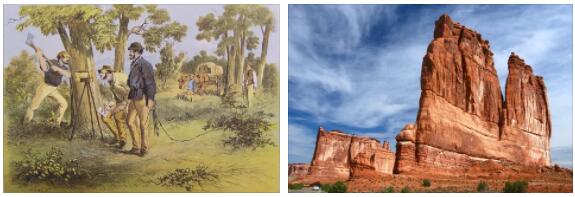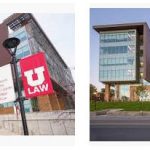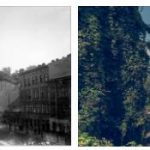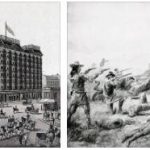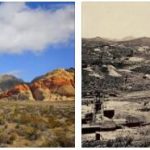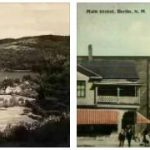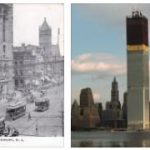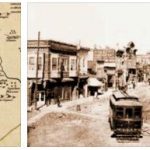Population: 2 817.222 thousand people (2011)
Area: 219887.0 sq. km
Utah belongs to the Mountain States. Despite the apparent homogeneity of landscapes, the “hive state” (nickname of the state) is distinguished by a variety of landscapes and bizarre natural forms. The state owes its name to the Indian tribe, which was called Ute – “children of the mountains.”
Utah is located at the junction of three geographical regions – the Colorado Plateau, the Great Basin and the Rocky Mountains. The highest ridge is Wasatch (up to 4100 meters). The Colorado River and its tributaries (San Juan, Green River) flow through Utah. There are several lakes on the territory of Utah: drainless Big Salt, Utah, Sevier. The climate in the state is arid, and the terrain is semi-desert. The forests found in the valleys and mountains are well preserved, as they are protected by law. In winter, the temperature fluctuates around zero, and in summer it reaches more than 30 °. The subsoil of Utah contains gas, coal, oil, copper, silver, zinc, and gold.
The Pueblo tribes that lived here in antiquity left mountain settlements and interesting artifacts. They were replaced by the Ute, Navajo, Paiute and Goshut. Back in the 16th century, the Spanish conquistadors F. de Coronado penetrated here in search of the mythical Seven Golden Cities. Detailed exploration of Utah began in 1774. For a long time, Utah was just a transit territory on the way to California. A great contribution to the study of the region was made by the hunters-Mountainmen, as well as the Mormons, who settled here in 1846. Two years later, the US got Utah, but refused to recognize the state of Deseret, created by the Mormons. In 1850, the Utah Territory was formed in its current borders. Since the 1860s, Indian reservations have been established here. In 1896, Utah became a state. In 2002, Utah’s capital, Salt Lake City, hosted the 19th Winter Olympics.
For tourists, Utah is an amazing natural attraction, concentrated mainly in five national parks. The symbol of Utah is the natural arches in the mountains, formed over millions of years by weathering and erosion. Monument Valley is also amazing – a plain with lonely rocks. Utah is a very popular region for the film industry. Many westerns and other adventure, historical and fantasy films were filmed here. The architectural symbol of Utah is the main Mormon temple in Salt Lake City. Utah has excellent infrastructure for winter sports.
WEST VALLEY CITY
Population: 108,900 thousand people (2000)
Area: 91.8 sq. km
Time zone: UTC-7, summer UTC-6
Altitude: 1312 m
Nearest airport: Salt Lake City
The western suburb of Utah ‘s capital, West Valley City, is the second most populated city in the state. The West Valley area operates the city’s transportation system and Salt Lake City street numbering. The Bangerter Expressway (SR-154) connects downtown to the Salt Lake City International Airport.
Before the arrival of European colonists, the Ute and Shoshone Indians lived on these lands. In the mid-19th century, early settlers, Mormon religious communities and Latter-day Churches, staked out lots for their future farms. After the development of an irrigation irrigation system for lands in the valley, farmers actively engaged in planting fruit trees and arable land for growing crops. By 1881, the crops began to bring the first stable income to the communities. After the Second World War, the number of settlements increased significantly and by 1970 it was decided to create the city of West Valley City on the basis of the four largest communities: Hunter, Granger, Chesterfieldand Redwood. For the young suburb, a program was developed for the urbanization of farms, including the laying of roads, communications, the construction of hospitals, schools and the creation of a single municipal space.
West Valley City is home to the Maverick Center, a multi-purpose sports arena that hosted the 2002 Winter Olympics ice hockey competition. It is the place of constant training of the Utah Grizzlies hockey team.
The shopping alleys of Valley Fair Mall have more than 120 stores and a Cinemark cinema. The northern and southwestern outskirts of the city have professional golf courses. Stonebridge and Westridge golf clubs are open at their base.
Here, not far from the Westridge field, there is a concert venue with an open-air stage – USANA Amphitheater. A regular venue for singing events and music festivals. The USANA lookouts provide an unforgettable view of the Wasatch Mountain Range, which stretches 260 kilometers along the border between Utah and Oklahoma.
The Rocky Mountain Raceways is an epic racing arena that hosts multi-purpose circuits ranging from drag racing to motocross. This is a place of constant battles of four-wheeled monsters.
WEST JORDAN
Population: 104.400 thousand people (2008)
Area: 80.0 sq. km
Founded: 1848
Time zone: UTC-7, summer UTC-6
Altitude: 1333 m
Nearest airport: Salt Lake City
The name of the city of West Jordan directly hints at its geographical location – it lies to the west of the Jordan River. The ridge of the Okkir mountain range serves as the western border. West Jordan itself is included in Salt Lake County and is part of the Salt Lake City metropolitan area. The local airport not only serves civilian flights, but also serves as a base for United States Air Force helicopters.
West Jordan was founded in 1848 by a community of Mormons who came to these lands (and became the first white settlers here) for their leader Brigham Young to build their Zion on God-given land. By the way, they named the name of the local river Jordan in honor of the sacred Jordan.
Initially, it was an exclusively agricultural community, which received city rights in 1949. But until the 1970s, West Jordan remained a minor town. It has grown in recent decades, primarily due to the expansion of the agglomeration of the Great Salt Lake valley and the resettlement of many residents from the capital of Utah to the surrounding area. Today, West Jordan hosts the campuses of the large Salt Lake Community College and the small Broadview University, which is engaged in research in the field of medicine.
The main attractions of West Jordan are concentrated in the historical center – Briarwood. There is a central park, a historical museum, an indoor entertainment center. The Old Quarter of Gardner Village is home to the main stores and malls of West Jordan. The main architectural monument of the city is the old building of the Mormon prayer house, within the walls of which the museum of the Utah Pioneer Daughters society operates.
St. George, Utah
History and Climate of St. George, Utah:
History:
- Early Inhabitants and Exploration: The history of St. George, Utah, dates back to the prehistoric Anasazi people, who inhabited the region thousands of years ago. Spanish explorers, including Dominguez and Escalante, explored the area in the 18th century. However, it was the arrival of Mormon pioneers in the mid-19th century that had a lasting impact on the development of St. George.
- Mormon Settlement: In 1861, a group of Mormon pioneers led by Brigham Young established the cotton mission in the St. George area. They aimed to grow cotton and other crops in the warmer climate of southern Utah. The settlers faced challenges, including arid conditions and conflicts with the local Paiute Native American population.
- Cotton Mission and Economic Growth: Despite initial challenges, the cotton mission played a significant role in the economic development of St. George. The pioneers successfully cultivated cotton, and the region became known for its agricultural contributions. The construction of the St. George Tabernacle, a historic building completed in 1876, symbolized the community’s growth and commitment to religious and civic life.
- Sugar Beet Industry: In the early 20th century, St. George transitioned from a focus on cotton to sugar beets. The sugar beet industry became a major economic driver, with the development of a sugar beet factory in 1916. The factory operated for several decades, contributing to the region’s prosperity.
- Mormon Temple Construction: The construction of the St. George Utah Temple, one of the early temples of The Church of Jesus Christ of Latter-day Saints (LDS Church), began in 1871 and was completed in 1877. The temple remains a significant religious and historical landmark in the city.
- Post-War Development: After World War II, St. George experienced growth and modernization. The city’s population expanded, and new industries, including tourism and retirement services, began to shape the local economy. St. George’s favorable climate and scenic surroundings contributed to its appeal as a destination for retirees and visitors.
- Recreation and Tourism: George has become a hub for outdoor recreation, attracting visitors with its proximity to Zion National Park, Snow Canyon State Park, and other natural wonders. The city’s red rock landscapes, golf courses, and cultural events contribute to its reputation as a recreational and tourist destination.
- Population Growth and Urbanization: In recent decades, St. George has experienced rapid population growth and urbanization. The city’s demographics have diversified, and its economy has expanded to include a range of industries beyond agriculture.
Climate:
According to Rrrjewelry, St. George, Utah, experiences a hot desert climate with mild winters, characterized by hot summers and relatively mild winters.
- Summer (June-August): Summers in St. George are hot, with average high temperatures often exceeding 100°F (38°C). The city experiences low humidity, and outdoor activities are popular during the early morning and evening hours. Summer is the peak tourist season due to the favorable weather conditions.
- Fall (September-November): Fall brings a gradual cooling of temperatures, with average highs ranging from the mid-70s to mid-80s°F (24-29°C). Fall is a pleasant time to explore outdoor activities, and the changing colors of the surrounding landscapes add to the visual appeal of the region.
- Winter (December-February): Winters in St. George are mild, with average high temperatures ranging from the mid-50s to low 60s°F (13-17°C). While snow is rare in the city, the nearby mountains may experience winter precipitation, contributing to the scenic backdrop. Winter is a comfortable season for outdoor recreation.
- Spring (March-May): Spring sees a gradual warming of temperatures, with average highs ranging from the mid-70s to mid-80s°F (24-29°C). As flowers bloom and trees regain their foliage, St. George experiences a renewal of life. Spring is an inviting time for outdoor activities and cultural events.
St. George’s climate attracts individuals seeking a warm and dry environment, especially retirees and outdoor enthusiasts. The city’s commitment to preserving its historical sites, promoting tourism, and providing recreational opportunities aligns with its natural surroundings and contributes to its identity as a thriving and vibrant community in southern Utah.
